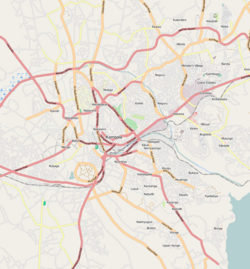Location
Kololo is close to the centre of Kampala, bordered by Naguru to the east, Bukoto to the north, Mulago to the north-west, Makerere to the west, Nakasero to the south-west, and Kibuli to the south. Kololo is in the Kampala Central Division. The coordinates of Kololo are 0°19'46.0"N, 32°35'41.0"E (Latitude:0.329445; Longitude:32.594725). [2] Kololo Hill rises to a maximum height of 4,302 feet (1,311 m) above sea level. [3]
Overview
Kololo gets its name from the 19th century Acholi Chief Awich, from Northern Uganda. He, along with Kabalega of Bunyoro resisted British rule. Awich was arrested and brought to Kampala and incarcerated on top of Kololo Hill. He is alleged to have cried out in Luo, “An atye kany kololo”, which means “I am here alone.” Awich was lamenting over the fact that he had been left alone in the wilderness, miles away from home. His captors and the Baganda started calling the location and the hill "Kololo", resulting in its name today. [3] [4]
Since the 1950s, before Uganda's Independence, Kololo has been an upscale residential area because of its central location in the city and to the views from the hill. Kololo is a popular location for diplomatic missions to Uganda, housing more than a dozen embassies and ambassadors' residences. [5]
During the 2000s, hotels, banks, hospitals, and other corporate entities began to infiltrate the hill, mainly to serve those who reside there, away from the noise and traffic congestion in the central business district located on the neighbouring Nakasero Hill. [2]
However, the introduction of business premises on Kololo Hill, especially restaurants and bars, has increased noise and has introduced heavy traffic that interferes with the serenity and ambiance that was there before. [6] Several irritated residents have jointly sued seven bars, accusing them of being the source of noise pollution. [7] As of February 2019, the case was still winding through Uganda's court system. [8]
This page is based on this
Wikipedia article Text is available under the
CC BY-SA 4.0 license; additional terms may apply.
Images, videos and audio are available under their respective licenses.


